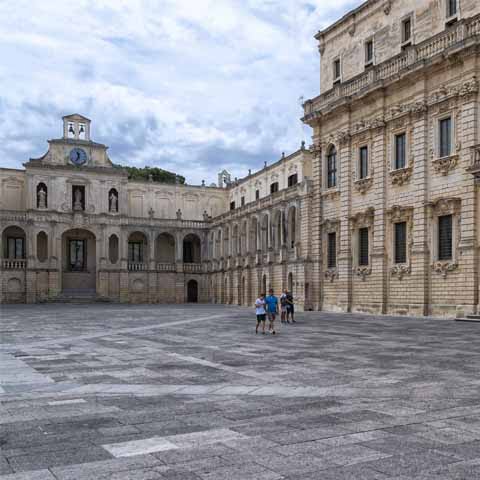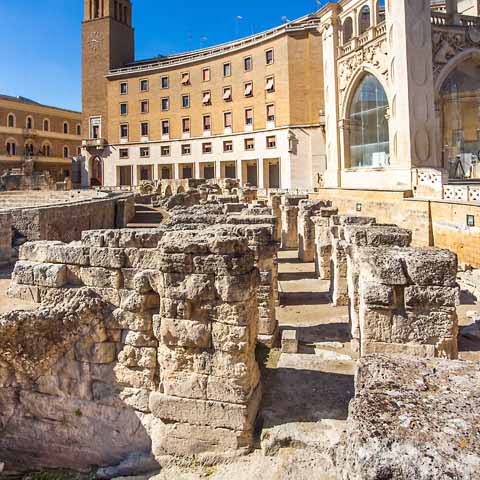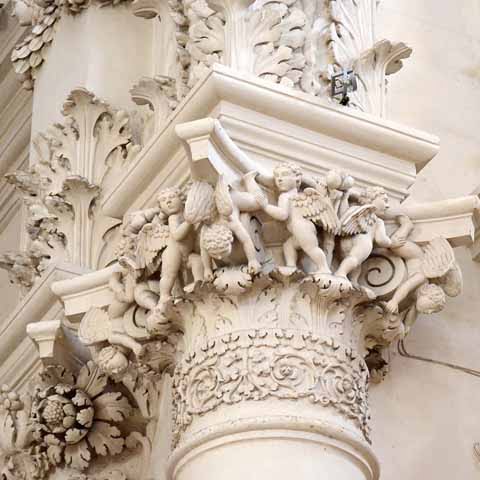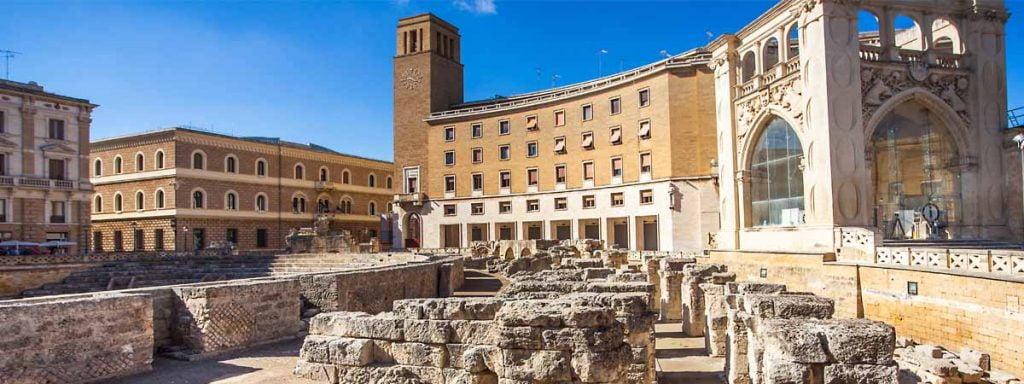Lecce is one of the most characteristic cities in Italy. Located in the Apulia region of Southern Italy, the municipality is separated from the sea by a 6-mile strip of land. Positioned in the heart of Salento, Lecce is considered the cultural capital of this area and of Apulia.
In fact, the morphology of the city highlights an original contrast between the old and the new. The Roman city was superimposed on the almost concentric nucleus of the original Messapian settlement, which disappeared following the destruction endured in the early Middle Ages.
Almost completely reconstructed in the Norman period, Lecce preserves the style even today, with its “short” appearance characterized by buildings that are short in stature. Under Charles V, the city received the trapezoidal bastion walls which defined the urban area until the second half of the nineteenth century.
But the style that defines this city is Baroque, which was established in Lecce between the seventeenth and the eighteenth centuries. In this period, the municipality witnessed a true building renovation inspired by the distinctive current. What makes the Baroque style different in Lecce is the use of the characteristic Lecce stone decorated with Baroque motifs on the façades of the buildings. This rather unusual mark of unique beauty gave Lecce the title of the “Florence of the South.”
From the second half of the nineteenth century, the New City started to raise around the Old City. The economic and developmental boom arrived after World War II, and today, Lecce is an important travel capital and center for history and culture.
PREHISTORY OF LECCE
It is believed that the origins of Lecce date back to the fifth century BC due to bas-reliefs and other artifacts belonging to that era that were found scattered throughout the city. According to one legend, however, Lecce had only been founded around the year 1200 BC, immediately after the destruction of Troy. Although there is no scientific evidence to support these facts, the tale narrates that it was the Greeks who introduced culture in Lecce for the first time.
Beyond assumptions and legends, the first testimonies that confirm the origins of the city are relatively recent archaeological finds that clearly indicate the Messapians, an Ancient Greek tribe, as the first protohistoric inhabitants of the territory.
Originating from the Balkan Peninsula, the Messapians settled in the Salento area in the third millennia BC, many centuries before the founding of Rome.
The Messapian center that would later transform into Lecce grew gradually and benefited from the successive invasions of the Greeks and the Romans. The first name of the settlement was Sybar, while the Romans changed this name to Lupiae. From this moment on, the name underwent many transformations up to the current Lecce.
HISTORY OF LECCE
The Romans conquered Salento, including Lecce, in the third century BC. Although the settlement did not have a strategic importance for the Capital, the Romans still contributed to the development of the city, especially during the reign of Emperor Hadrian. This considerable development continued under Marcus Aurelius; in fact, under his rule, Lupiae’s economy flourished.
The Romans built their city walls above the original Messapian plan and embellished the city with traditional public buildings, such as the forum and an amphitheater. Apart from these edifices, the Romans also built a theater and gave this inland city an outlet to the sea, the current Marina of San Cataldo.
But this period of growth ceased with the fall of Rome. The city was severely and repeatedly devastated by both the Barbarians and the Ostrogoths towards the middle of the sixth century AD. When the Ostrogoths were defeated by the Byzantines, the city fell under the domination of Constantinople, remaining obscured for the upcoming centuries by the more powerful Otranto, the Byzantine capital of Salento at the time.
During this period, the city endured the attacks of the Turkish pirates, of the Huns and of the Slavs. Sieged by various conquerors, Lupiae slowly died out, declining from a mighty municipality to a mere borough.
But this dark period ended in the eleventh century, with the fall of Byzantine rule in Southern Italy.
The Normans, ruled by Robert Guiscard, established themselves in Apulia at the beginning of the eleventh century, and around 1060 AD the city was granted the statute of the county seat and became the provincial capital under the rule of the Hauteville family. Under the Normans, the ancient name of Lupiae was changed to Licea, then Licium, the two forms from which the name Lecce developed.
The Hautevilles had an opulent and sumptuous court. Considering themselves protectors of arts and literature, the counts decorated the city with magnificent buildings and Lecce flourished under their rule; numerous edifices were erected while others benefited from restoration works.
The Hauteville dynasty ended in the thirteenth century, and for a short time, the Swabians took possession of the city. However, they were defeated in 1226 by the Anjou. Later, Lecce passed to Walter IV, Count of Brienne, who became Duke in the area. But the count enjoyed only the title, because it was his son, Hugh of Brienne, who truly conquered the area from the domain of the Swabians.
Lecce remained a domain of the Brienne until the fourteenth century, when the county passed to Walter III of Enghien, the husband of Isabella, Countess of Brienne. With Walter’s death, the whole county passed to the Enghien dynasty again, and then to Raimondo Del Balzo Orsini, count of Nola and husband of Maria of Enghien.
Under the rule of Raimondo Del Balzo Orsini, the small county of Lecce was incorporated into the principality of Taranto, ruled by the same dynasty. But with the death of Raimondo at the beginning of the fifteenth century, Lecce returned to his wife, Maria, and during this century the city became an important commercial center that developed into an area of cultural richness.
With the Salento Renaissance, Lecce got new city walls and an imposing Triumphal Arch. Additionally, work on other landmarks began, including the Basilica of Santa Croce.
With the death of the last representative of the Counts of Lecce in 1463, the domain lost its autonomy and was incorporated by Ferdinand I of Aragon, the King of Naples, into his possession. From then on, the history of Lecce followed the fate and vicissitudes of the other lands of the Kingdom of Naples.
Towards the end of the fifteenth century, a noteworthy event that occurred was the fierce defense of the coast against the attacks of the Turks.
At the beginning of the sixteenth century, Lecce passed under the Spaniards and Charles V. But the king only provided to the construction of the castle and the reinforcement of the city walls, to improve the defense against the Saracen threat.
While the fifteenth and sixteenth centuries were characterized by peaceful policy and overall tranquility, the advent of the seventeenth century changed this situation. The seventeenth century was, in fact, a turbulent one, characterized by struggles and disorders caused by the anti-Spanish and anti-feudal movements. Yet, it was also during this time that many of Lecce’s most important Baroque monuments were constructed.
In 1647, Lecce joined Naples in the Revolution of Masaniello, then sided with the Neapolitan Republic. This period of political and social instability was accentuated even more with the terrible plague epidemic in 1656, followed by natural disasters that claimed thousands of victims.
During the eighteenth century, in the wake of the Enlightenment movements, the political and social consciousness of the people of Lecce deepened. Numerous schools, including the school of mathematics and that of law, emerged in this century.
But this century was also characterized by several episodes of revolt caused by the elevated level of taxes and by the arrogance of the ecclesiastical class.
In 1734 the domination of the Bourbons began under the rule of Charles III.
During the Risorgimento, Lecce conspired for national independence and offered refuge to numerous fervent patriots. Among these was the Duke Sigismund Castromediano who endured heavy torture exerted by the Bourbons during long years of imprisonment.
After the Unification of Italy, the city began to expand beyond the city walls, while at the beginning of the twentieth century, the province of Lecce was detached from Taranto and Brindisi. From then on, Lecce began an independent path of cultural and economic growth that impacted both the city of Lecce and the area of Salento as a whole.
Acquiring an impressive artistic beauty and economic importance, Lecce compares to the leading cities in Italy and is an important travel center and cultural hub.
ARCHAEOLOGY OF LECCE
The ancient origin of Lecce is attested by numerous archaeological remains scattered throughout the city. The open-air sites testify to the Roman legacy, but there are dozens of artifacts belonging to the other prehistoric and historic eras housed in the museums of the city.
From the Roman era, one of the most characteristic sites is the Roman amphitheater located in Piazza Sant’Oronzo. Built in the second century AD, the amphitheater hosted entertainment shows for the Roman garrison and could accommodate over twenty-five thousand spectators. Buried under the newer layers of the city, the amphitheater was discovered during excavations after World War II and is impressively well-preserved.
The Archaeological Park of Rudiae is another archaeological marvel of Lecce, although only few people are aware of its existence. However, this site has a great historical and cultural importance, representing one of the fundamental sites that helped to rediscover the origins of the city.
The walls of the original settlement are still visible, while the area is rich in relics. Although Rudiae is a former Roman settlement, its importance derives from the underground stratification of eras that show immutable evidence of the passage of the various cultures.
Among the numerous museums of Lecce, the Provincial Archaeological Museum Sigismondo Castromediano is noteworthy. As the oldest museum in Apulia, it was commissioned in 1868 by the Duke Castromediano and houses rich collections of ancient finds from Lecce and Salento.
One of the most impressive collections in the museum is that of Messapian ceramics, but the imperial age statues are striking as well. Archaeology apart, the museum also hosts a permanent collection of paintings arranged in a medieval and in a Baroque room.
Faggiano Museum, opened in 2008, is an internationally-renowned private museum that emerged after the discovery of several ancient buildings under a private residence. Among them, are a Messapian house floor and a Roman barn. Transformed into a museum, the house now hosts numerous temporary exhibitions while the excavations below the house are also accessible to the public.
The Museum of the Roman Theater, attached to the Roman amphitheater, contains artifacts resulting from excavations carried out in the first half of the twentieth century, including a series of nine theatrical masks found in Villa Adriana in Tivoli.
Also noteworthy is the Historical-Archaeological Museum MUSA. This museum was inaugurated in 2007 with the purpose to strengthen the educational services and the historical-archaeological research of the university.
The museum is divided in five halls arranged in an itinerary that highlights the fundamental milestones that marked the growth of the historical-archaeological sector of the University of Salento, including illustrations and representative samples relative to the various prehistoric and historic stages.
Over three hundred artifacts and reproductions of the archaeological context contribute to understanding the history of Lecce and its region.
The MUST Museum, located in the historic center of Lecce is housed in the fifteenth-century monumental Monastery of Santa Chiara. It features testimonies of the various eras that marked Lecce’s history, from the Messapian age and the Romans to the twentieth century. The museum also hosts a permanent art gallery exhibiting contemporary works.
Don't just see Italy, live it.
Your dream trip to Italy has never been closer
No more endlessly scrolling travel sites. Our travel experts will craft the perfect, one-of-a-kind trip just for you.

300+
DESTINATIONS
We offer more Italian destinations than any travel site. Do and see more with Trips 2 Italy.
1 (of a kind)
ITINERARIES
Because your dream trip to Italy should be designed for you, not for the masses.
100%
PEACE OF MIND
From flights and accommodations, to food and activities - we take care of every detail.






